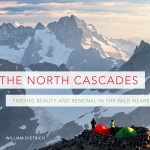A full moon was setting over the San Juan Islands when my wife and I got up this morning.
The path of moonlight seemed like an approving omen. This St. Patrick’s Day is the 16th anniversary of our move into this view home in Anacortes, WA. We’ve enjoyed the water, trees, and storms ever since.
 Dry winter, wet spring, sun today, and a blessed escape from the snowstorms that have hammered the eastern half of the country. Snowing in D.C.? Here near Canada the blossoms are out.
Dry winter, wet spring, sun today, and a blessed escape from the snowstorms that have hammered the eastern half of the country. Snowing in D.C.? Here near Canada the blossoms are out.
It was sunny the day we moved in, too. Trust me, that ain’t normal for these rainy parts in March.
Ours is a comfortable but peculiar house picked after our youngest went off to college, built on a rock bluff so steep that a few feet of the living room is actually cantilevered over the top of the foundation. A deck extends beyond that.
The house has three floors, but instead of being atop each other they step side by side to hug the boulder’s bulges. The 1982 builders who chose the lot were crazy, but in a good way.
The result feels like a tree house, perched on an igneous rock called gabbro that was once on the ocean floor.
As I wrote that sentence, a bald eagle flew about fifty yards off my office window. Yes, we are fortunate! Great blue herons, osprey, ducks, and gulls.
This is the office where I’ve written most of my books. The view is an integral part of my writing, because landscape and environment creeps into everything I do, whether fiction or nonfiction.
The next Ethan Gage novel coming in May, The Three Emperors, relies on the atmospheric mood cast by Venice, Prague, and the castles of the Czech Republic. All the Gage books have striking settings.
A young adult novel I’m nearing completion on starts in the foggy Northwest and jumps to prehistoric East Africa, inspired in part by a hike we took between two volcanoes there. It’s an adventure thriller and eco-fable, reminiscent in some ways of my second novel, Getting Back.
And I’m the lead author on a group-effort book on the North Cascades by the Mountaineers Press that comes out in October. It’s a coffee table book with absolutely stunning pictures.
To expect people to buy The North Cascades for my essays is like men claiming they buy Playboy for the articles. Each of the book’s images is worth well over a thousand words.
But I’m proud to have contributed to an inspiring package about an absolutely glorious mountain range in my backyard.
Great Christmas gift, by the way.
If I look out my office window, I see three uninhabited San Juan islands. If I drive into town, I see the snow-clad Mount Baker and the Twin Sisters. It’s a truly remarkable place to live.
Western authors tend to write a lot about landscape because it’s so dramatic and in our face. Noodling on paper is sort of like prayer – our hope that if we write enough about it, with sufficient eloquence, maybe our grandchildren get to keep it.
My life has seen the swing from industrial to post-industrial society, and from anxious preservation to slow and steady restoration. Literally thousands of people do good volunteer things for the environment in the small county where I live. There is routine stewardship that didn’t exist when I was young.
Much of my own writing, from journalism to novels, is less about the interior life of the mind and more about the exterior world of environment and its affect on spirit, both as threat and salvation. The world’s population has more than doubled in my lifetime and for all the wars, recessions, disasters, and scandals, the epoch’s biggest story is the struggle to strike a sustainable balance with our planet.
On any given day I range from the pessimistic to optimistic about our chances. Today, with white surf, budding greenery, a stiff wind and local daffodil and tulip fields nearing commercial bloom, I’m an optimist.
There’s a fun HDTV program about buying homes in Hawaii with the motto, “You don’t have to be rich to live in Hawaii, you just have to want it.” Not entirely true – the real estate looks pretty pricey to me – but desire is central to the motivation of any fictional character, and central to our own lives.
We don’t have to be rich to cherish and sustain our planet. We just have to want to.

